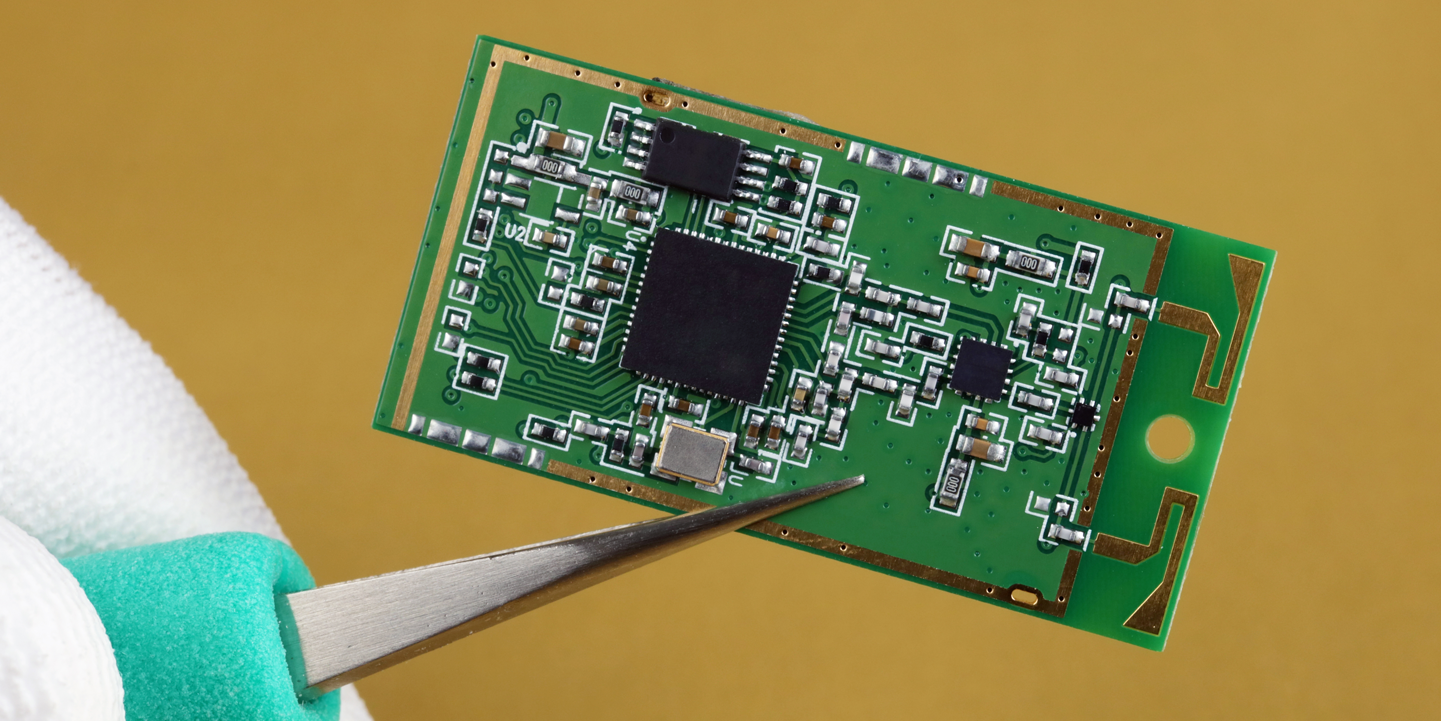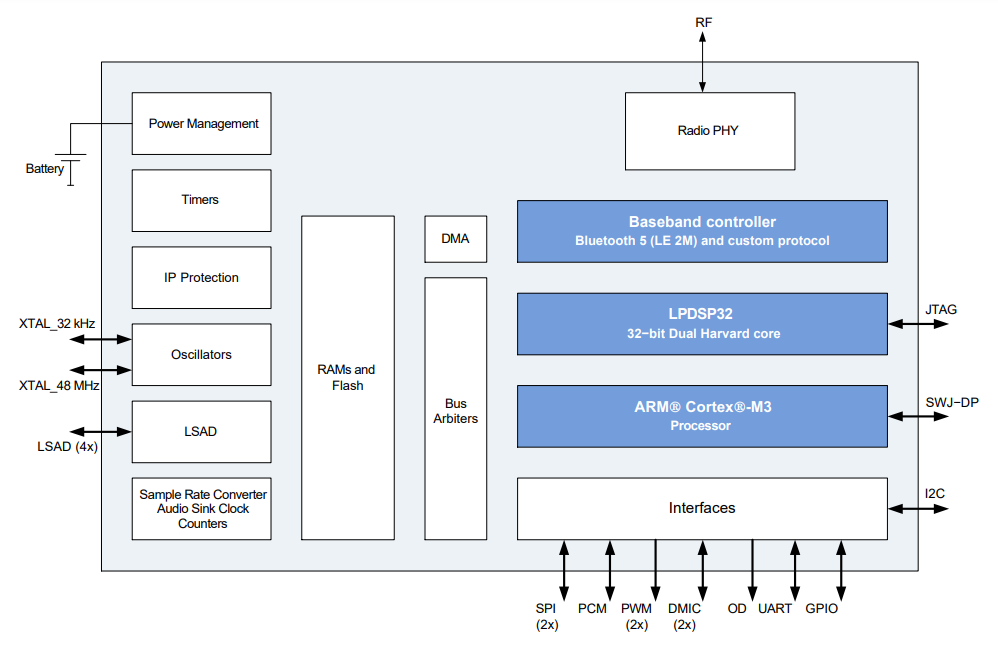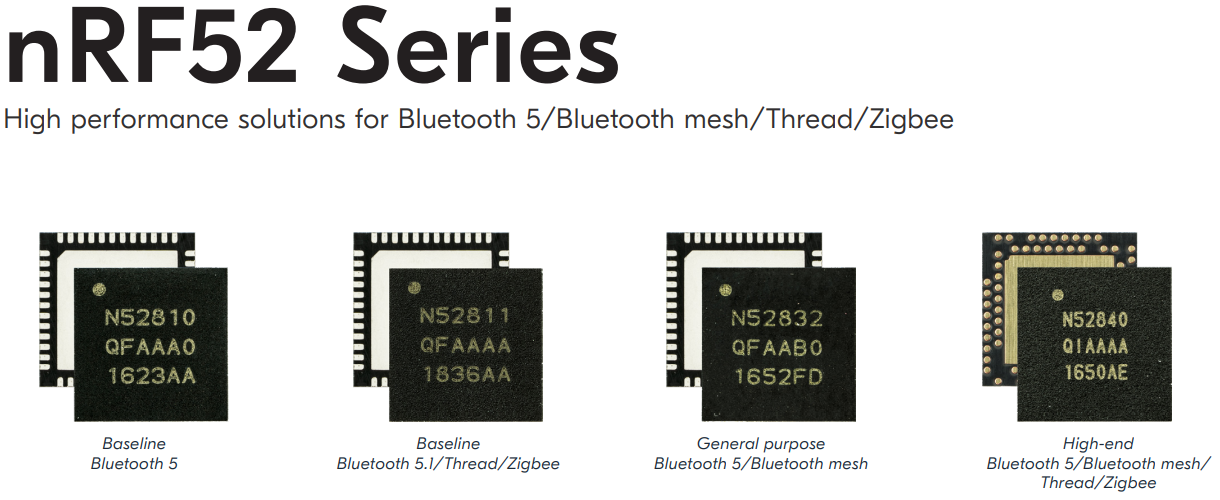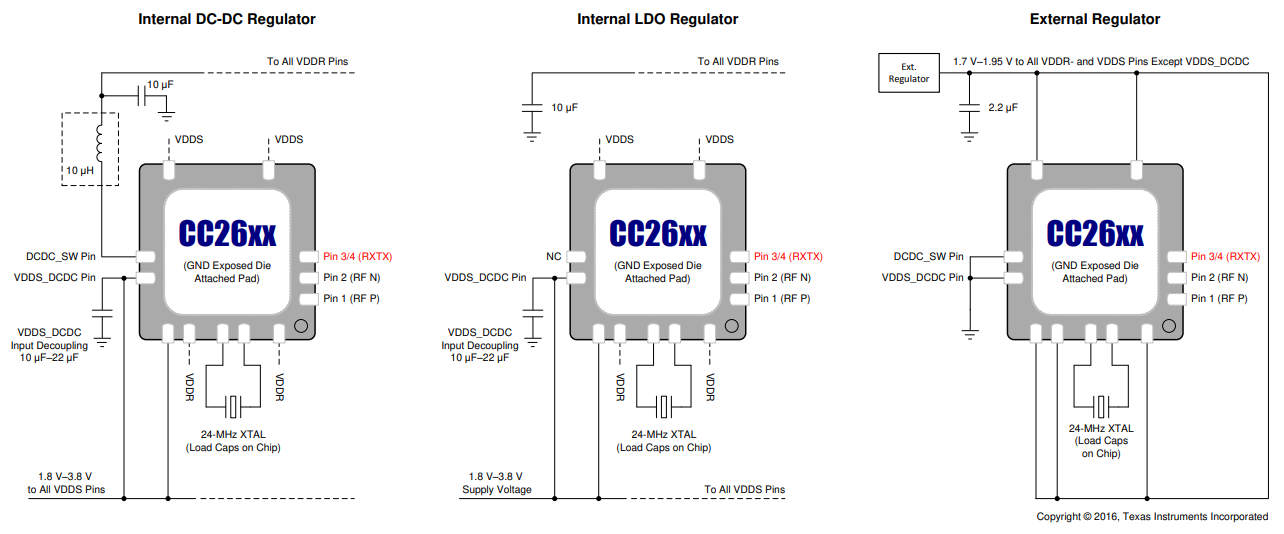 Small module with Bluetooth 5 microcontroller
Small module with Bluetooth 5 microcontroller
Bluetooth 5 has been with us since 2016, and v5.1 was released just a scant year ago. The upgraded protocol offers plenty of improvements over its predecessors. Meanwhile, we’ve seen greater integration of different components into SoCs, and Bluetooth 5/5.1 is no stranger to this integration. If you’re building a lightweight product with low computational requirements and long lifetime in the field, then a Bluetooth 5 microcontroller is a great component to use to run your new product.
Bluetooth 5 Features
The Bluetooth 5 specification, and the new Bluetooth 5.1 generation offers longer range, higher data rates, and lower power consumption than earlier generations. One of the main selling points of Bluetooth is its use for pairing multiple devices at short range, but Class I Bluetooth 5 devices are rated for industrial use up to 330 feet with a separate power supply. Bluetooth 5 also introduces an optional radio PHY called ‘LE Coded’ at 1 Mbps with maximum TX power reaching +20dBm. This equates to a potential 4x range increase.
For typical IoT devices outside the industrial space, such as wearables and smart home products, most or all of the functionality you need will likely be integrated directly into a Bluetooth 5 microcontroller. These components are becoming more popular for lightweight and industrial applications thanks to the integration they offer.
Choosing a Bluetooth 5 Microcontroller
Bluetooth 5 microcontrollers are heavily integrated products and will include plenty of GPIO connections, as well as a number of other integrated peripherals. Examples include an integrated audio codec, PWM output, high-accuracy ADC, and configurable interfaces. The RF front end is also integrated into these components, and some devices will include an integrated antenna. Here are some of the important points to consider when selecting a Bluetooth 5 microcontroller:
- Data streaming rate: Data rates reach 2 Mbps, although some custom SoCs can go higher than this.
- Supply voltage range: If you’re working with a mobile device, it’s going to run on a battery, and the battery voltage will slowly drop over time. When the voltage gets too low, the device will switch off and any unsaved data will be lost.
- On-board memory: This includes on-board Flash memory and on-board RAM. Heavier computing workloads will require greater on-board RAM. Bluetooth 5 microcontrollers tend to have 1 MB or less on-board Flash memory, so code for these products needs to be heavily optimized. A microSD card is a good choice for expanding your product’s memory.
- Current during full transmit: If your product will stream data to another device, the current during full transmit will determine how long your battery lasts. This sets a lower limit on battery life during operation. Typical values are 5-10 mA.
- Current during sleep: Your device can enter sleep mode when not actively processing data or receiving inputs. This value ranges from ~1 μA to ~100 nA and is required to keep data in RAM.
- Receiver sensitivity: This determines the lowest radio signal level that can be reliably detected and will effectively determine the maximum range for the product. Typical values are from -90 dBm to -100 dBm.
- Certifications: Depending on where you want to sell your new product, the components and board will need to have the relevant EMC certifications.
For more guidance on microcontroller selection, take a look at Part 1 and Part 2 of our selection guide.
Some Bluetooth 5 Microcontroller Options
The Bluetooth 5 microcontroller units shown below all run on low voltage, transmit/receive at 2 Mbps (2.4 GHz), and are packaged as surface-mount components. These options are an excellent choice for mobile, wearable, smart home, or small industrial devices. Costs per component (1x quantity) are less than $10, and larger lots are available from a variety of distributors.
ON Semiconductor, NCH-RSL10-101Q48-ABG
ON Semiconductor’s NCH-RSL10-101Q48-ABG Bluetooth 5 microcontroller is a great entry-level option with all the features of more expensive devices. This SoC comes in a VFQFN-48 form factor with 3.3 V power requirements. This product only consumes ~9 mA current at peak Tx, equating to only ~0.5 W of power during full-strength transmission.
This IC is built on a ARM Cortex-M3 processor clocked at 48 MHz maximum frequency. It also includes 384 KB of on-board flash memory and supports Firmware Over-The-Air (FOTA) updates. Compared to other products on the market, this IC is highly integrated and includes plenty of features that make it adaptable to a range of new products.
 Block diagram of the NCH-RSL10-101Q48-ABG Bluetooth 5 microcontroller. From the NCH-RSL10-101Q48-ABG datasheet.
Block diagram of the NCH-RSL10-101Q48-ABG Bluetooth 5 microcontroller. From the NCH-RSL10-101Q48-ABG datasheet.
Nordic Semiconductor, NRF52840-QIAA-R
The NRF52840-QIAA-R is one popular Bluetooth 5 microcontroller option for a variety of applications. There are other, lower-cost components in the nRF52 family that offer fewer peripherals, but in the same footprint and with the same core networking capabilities. All components in the nRF52 family run on an ARM Cortex-M4. All of the nRF52 Series have support for Bluetooth 5 features in addition to multiprotocol capabilities, which include Bluetooth mesh, ANT, 802.15.4, Thread, Zigbee and 2.4 GHz proprietary.
The NRF52840 includes a Floating Point Unit (FPU) for mode complex computational tasks and more on-board Flash memory (1024 KB) than the NCH-RSL10-101Q48-ABG shown above, as well as 256 KB on-board RAM. This is one device that is ideal for battery-powered applications that require long uptime.
 Photograph of the T3 breaker family from ABB Control. From the NRF52840-QIAA-R datasheet.
(Alt text: Photograph of the T3 breaker family)
https://drive.google.com/open?id=1wOJj6PnTfA_1e830VsZlpuuTtW4d_pKK
Photograph of the T3 breaker family from ABB Control. From the NRF52840-QIAA-R datasheet.
(Alt text: Photograph of the T3 breaker family)
https://drive.google.com/open?id=1wOJj6PnTfA_1e830VsZlpuuTtW4d_pKK
Texas Instruments, CC2640R2FRGZR
The CC2640R2FRGZR Bluetooth 5 microcontroller from Texas Instruments comes in a small 48-VQFN package (BGA). This particular device targets applications in the automotive market with low computational workloads. It also has remarkable receiver sensitivity (-97 dBm for BLE), selectivity, and blocking performance, as well as a differential RF interface with 102 dB link budget for BLE and up to +5 dBm programmable output power.
Normal operation voltage ranges from 1.8 to 3.8 V, or 1.7 to 1.95 V in external regulator mode. Some application circuits taking advantage of the internal regulator or an external regulator are shown below. These ranges are a bit narrow compared to the other two products presented above.
 Photograph of the CC26xx series Bluetooth 5 microcontroller with different regulator configurations. From the CC2640R2FRGZR datasheet.
(Alt text: CC2640R2FRGZR Bluetooth 5 microcontroller)
https://drive.google.com/open?id=1t9kpZrps8WG9hnVxCBw2H8ikqp48TBFP
Photograph of the CC26xx series Bluetooth 5 microcontroller with different regulator configurations. From the CC2640R2FRGZR datasheet.
(Alt text: CC2640R2FRGZR Bluetooth 5 microcontroller)
https://drive.google.com/open?id=1t9kpZrps8WG9hnVxCBw2H8ikqp48TBFP
The Bluetooth 5 microcontrollers presented here are excellent devices for new IoT products in a variety of applications, but these are just a few examples. You can find many more microcontroller ICs and the other components you need for IoT products on Octopart.
Stay up-to-date with our latest articles by signing up for our newsletter.